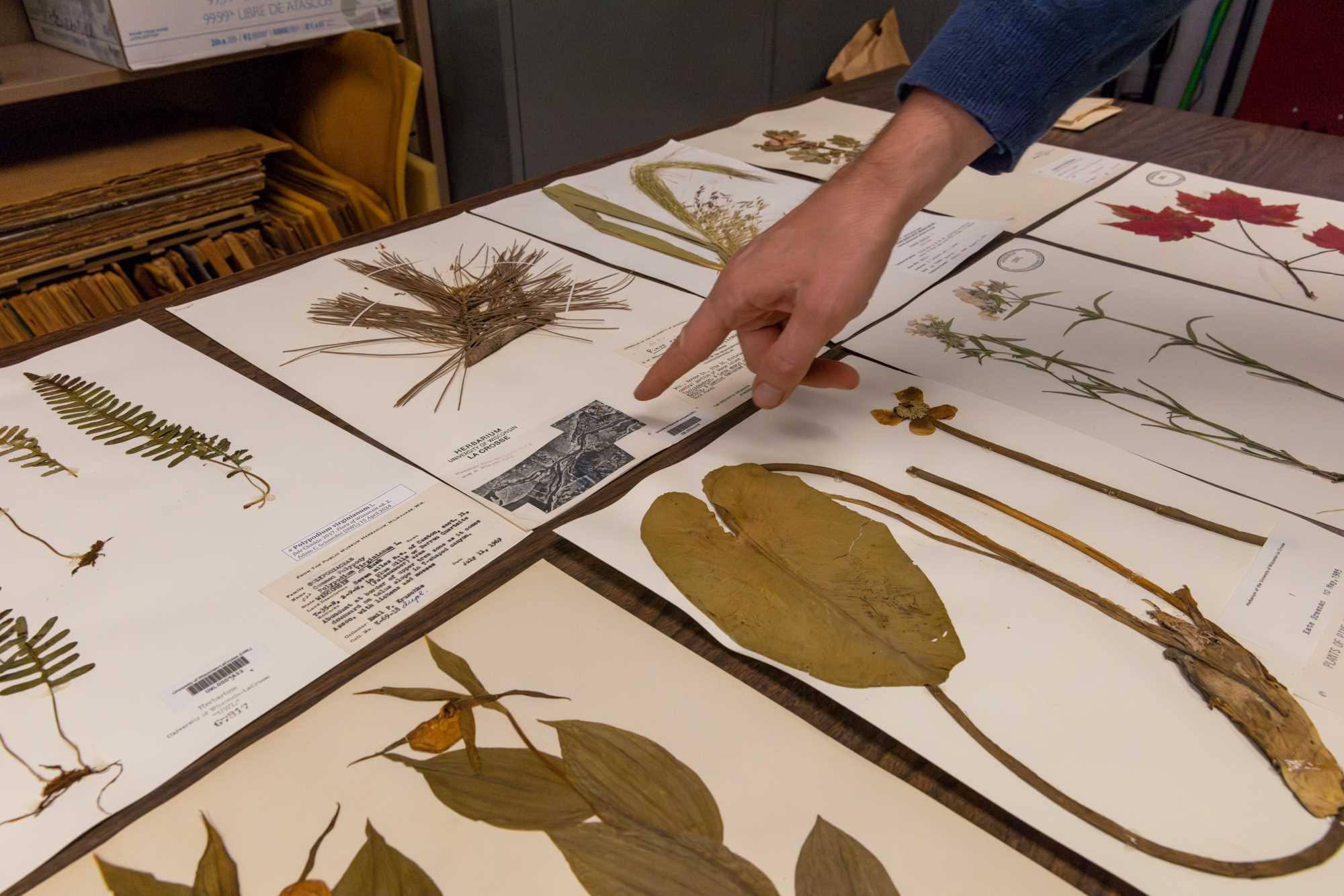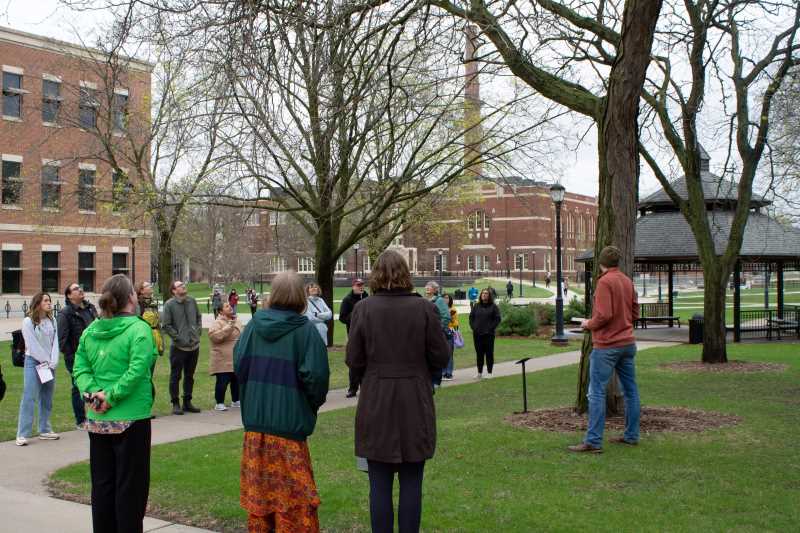Herbarium
A page within River Studies Center

What is an herbarium?
An herbarium is a collection of preserved plant specimens. Plants are pressed in the field by researchers between paper and cardboard. Each specimen is labeled, affixed to archival paper, and stored in an organized way based on the scientific name of the plant and the location where it was collected. Labels include information like scientific name, re-identifications, the location where the plant grew, the name of the collector and date of collection. Sometimes other information such as habitat or other plants growing in the area are also included. Herbarium specimens can be collected by anybody! Professional botanists, professors, students, and botanical enthusiasts have all contributed specimens to the UWL herbarium.
Herbaria document the diversity of plant species growing in a specific area at a specific time. They are often used for taxonomic research and identification reference and are also a source of plant DNA for research in medicine and evolution. Herbaria also play an important role in conservation and studying climate change. Specimens serve as a record of species and communities, invasive, endangered, or extinct plants, plant diseases, and changes in biodiversity.
Herbaria are vital natural history resources, and it is important to maintain them and the wealth of information they hold.
History
Initially, the word herbaria referred to books about medicinal plants. The first collection of preserved plant specimens was called a dry or winter garden and was started in the 16th century by Italian botanist and physician Luca Ghini. In early herbaria, specimens were bound into books. It wasn’t until Carl Linnaeus (1750s) that specimens were kept unbound on individual sheets, in organized cupboards.
Early herbaria were usually maintained by physicians, as they used plants for medicinal purposes. Now, herbaria serve a wide range of functions.
UWL's Herbarium
The UWL Herbarium contains approximately 60,000 specimens, mainly from the Driftless Region of Wisconsin and Minnesota, but also from other states and countries. A portion of the specimen records are digitized, imaged, and are available on WisFlora (https://wisflora.herbarium.wisc.edu).
Herbarium specimens play an important role in training UWL students and regional professionals in plant identification and collection techniques, preparing them for careers in natural resource management, horticulture, and conservation.
The UWL Herbarium is open to the public by appointment with Dr. Adam Schneider.
The importance of an Herbarium
Herbaria provide insight into native plant biodiversity and methods to protect it
Michigan State University researchers collected and databased specimens from Baker Woodlot, a protected area of high biodiversity on the MSU campus. Two surveys conducted 40 years apart (1969 and 2009) showed that despite being a protected area, rate of native species loss in Baker Woodlot was about 5 species per decade, while nonnative species increased.
Citation: Matthew R. Kolp (2019) Declining Native Species Richness in Natural Areas in Eastern North America: An Example from Baker Woodlot in Central Michigan
Herbaria help predict possible future changes to plant phenology
While herbaria are often an underutilized resource, herbaria specimens provide a record of past environmental conditions that can be used to help us understand changes over long periods of time. In one study, herbaria specimens representing 200 plant species collected over a period of 120 years from across the eastern US were gathered and used to better understand the impact of urbanization on plant flowering and fruiting times. The results of the study showed how the impacts of urbanization advanced flowering in colder areas and delayed fruiting in wetter regions.
Citation: Daniel S. Park et al. (2023) Complex climate-mediated effects of urbanization on plant reproductive phenology and frost risk
Herbaria help us discover new medical uses of plants
Specimens of genus Eriodictyon from the San Diego Museum of Natural History were used in a study investigating their potential use in therapies for dementia and Alzheimer’s disease. Several species were found to have strong neuroprotective and anti-inflammatory activities. Specifically, the plants contain the chemical sterubin, which has been found to protect neurological cells from breaking down.
Citation: Pamela Maher et al. (2020) The Value of Herbarium Collections to the Discovery of Novel Treatments for Alzheimer’s Disease, a Case Made with the Genus Eriodictyon
Herbaria help conserve indigenous cultures and practices
Indigenous plant knowledge includes things like plant blooming and fruiting times, plant/animal interactions, and varied uses for plants such as for medicine and food.
The Karuk, Yurok, Tebiwa tribes all govern their own herbaria, maintaining the identity and cultures of indigenous people and preserving their knowledge of local plants. Together, anthropologists and ethnobotanists have found there is a link between the extinction of species and extinctions of local languages. In these indigenous herbaria the plants are organized by tribal names, rather than by family and genus. As a result, this preserves not only the knowledge about the plants, but it also helps preserve tribal languages.
Citation: Megan Mucioki (2019) Creating herbaria with tribes in the Klamath River Basin
Herbaria help us improve methods of controlling plant diseases
Herbaria specimens can be used in researching the rise and evolution of plant pathogens and tracking the spread of diseases in plants. In one study, an infected specimen from the Mauritius Herbarium, collected in 1937, was used to reconstruct the genome of the pathogenic bacterium responsible for Asiatic citrus canker. This pathogen causes damage to citrus crops worldwide.
Citation: Paola E. Campos et al. (2021) First historical genome of a crop bacterial pathogen from herbarium specimen: Insights into citrus canker emergence
Herbaria help us increase crop resilience
As the population grows, we’ll need to feed more people more efficiently – and use less land in the process. As the impacts of climate change intensify, we also need to increase crop resilience to harsh environmental conditions.
Research is being done on crop wild relatives and the ways these plants can potentially improve future crop breeding. Crop wild relatives are very accessible through herbaria. At the University of Florida, digitized specimens are being used in ecological niche modeling to determine niche suitability of crop wild relatives in various climate scenarios. Herbarium specimens are also being used in DNA identification of crop wild relatives, research on domestication origins, and evolutionary origins of beneficial agricultural traits, such as nitrogen fixation.
Citation: Makenzie Mabry (2022) Crop Wild Relatives and the Role of Herbaria in Future Food Crop Security
Herbaria give insight into pollution levels
Herbaria specimens can be used to compare pollution levels in historical specimens to current plants. Historical specimens can also give insight into how long a given area has been contaminated by heavy metals.
Researchers at Brown University collected plants from around Providence, RI, from 1846-1916 were compared to plants collected in 2015 to determine changes in the concentrations of heavy metals - specifically copper, lead, and zinc. The study found that copper and zinc concentrations stayed relatively the same, but lead concentrations decreased, likely due to EPA regulations and remediation efforts.
Citation: Sofia M. Rudin et al. (2017) Retrospective Analysis of Heavy Metal Contamination in Rhode Island Based on Old and New Herbarium Specimens
Herbaria aid in research to prevent the spread of disease
Chronic wasting disease is a fatal disease found in deer. However, research at UW-Stout shows the potential for certain enzymes in lichen to help combat the disease by degrading the infected prion proteins. Herbaria specimens were used alongside citizen science data to evaluate the impact of certain species of lichen on the spread of CWD. The enzymes present in the lichen could possibly be an outdoor treatment for CWD and could already be reducing the extent of the disease.
Citation: Lauren D. Moss Gritzmacher (2022) Use of Citizen Science and Herbaria Records for Co-occurrence Modeling of Lichen and Chronic Wasting Disease in Wisconsin.
Herbaria help us understand genetic diversity in plant populations
Genetic diversity allows a species to better adapt to changes in its environment. As climate change progresses it becomes more important to maintain genetic diversity.
Starting in the 1930s elm populations across North America were devastated by Dutch elm disease (DED). A study in Wisconsin compared herbarium specimens of slippery elm (Ulmus rubra) to newly collected wild samples. The herbarium specimens represented the genetic diversity of slippery elm populations before the introduction of DED. Comparing the two sets of samples, researchers found that modern slippery elm populations have retained genetic diversity similar to pre-DED populations. It is important to conserve this genetic diversity in slippery elm populations so that this species retains its ability to adapt to our changing climate.
Citation: Johanne Burnet et al. (2016) Conservation of genetic diversity in slippery elm (Ulmus rubra) in Wisconsin despite the devastating impact of Dutch elm disease
Herbaria help us conserve declining plant populations
A study in Minnesota looked at the status of prairie dropseed (Sporobolus heterolepis), an important native grass, as there is concern about populations declining statewide. Historical herbarium records were compared to population counts collected by the Minnesota DNR. The collected data highlighted populations that showed signs of decline, allowing “customized management plans” to prevent the loss of entire populations.
Citation: Katherine Brewer et al. (2022) Using herbarium collections and species observation databases to assess the conservation status of prairie dropseed in Minnesota
Herbaria inspire artists
While herbaria are often used for scientific research, they also offer inspiration to artists. A survey conducted in 2016-2017 at the British Museum found that approximately 5% of visitors to the herbarium were there because of the aesthetics of plants.
Toronto-based artist Amanda McCavour created a large-scale embroidered installation inspired by the collections at the Wisconsin State Herbarium. The installation featured native Wisconsin plants and was on display at Chazen Museum of Art in 2022.
Citations: Mark A. Carine et al. (2018) Examining the spectra of herbarium uses and users
Emma Roberts (2022) Wisconsin’s prairies reimagined through the Chazen’s new multi-story exhibit


















